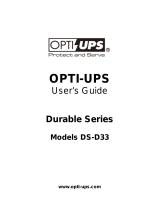Specifications
(continued)
+ Backup times are expandable with additional Battery Packs, sold separately. The policy of Tripp Lite is one of continuous improvement. Specifications are subject to change without notice.
Regulatory Compliance Identification Numbers
For the purpose of regulatory compliance certifications and identification, your Tripp Lite product has been assigned a unique series number. The series number can be found on the product nameplate label, along with all required
approval markings and information. When requesting compliance information for this product, always refer to the series number. The series number should not be confused with the marking name or model number of the product.
Model: SU30K3/3INTXR5
Input
Input Voltage 220/380, 230/400, 240/415V AC,
3ø, 4 Wire (plus ground), wye
Input Frequency 50/60 Hz ± 3 Hz (auto-selectable)
Voltage Correction Range 156-280/270-485V AC
Input Current (Per Phase, On-Line) 45A/43A/41A
Inrush Current <300A
Power Factor (Full Load) >0.95
Efficiency (Full Load/On-Line) >91%
Circuit Breaker 63A (3p)
Input Bypass Circuit Breaker 63A (3p)
Output
VA 30000
Watts (Power Factor: 0.8) 24000
Waveform (On-Line) Sinewave
Waveform (On-Battery) Sinewave
Output Voltage (RMS) User-selectable 220/380, 230/400,
240/415V AC, 3ø, 4 Wire (plus ground), wye
Output Frequency 50/60 Hz (auto-selectable)
(± 0.1 Hz on battery)
Voltage Regulation ±2%
Max. Harmonic Distortion
(Non-Linear Full Load) <5%
Overload Capabilities
<
102% (continuous), 102%~125% (1 min.),
125%~150% (30 sec.),
>
150% (2 sec.)
Short Circuit Capability
>
250A
Crest Factor 3:1
Battery
Battery Type Sealed, Lead Acid, 240V DC, 9AH
Battery Pack Quantity Five Packs (20 12V DC Batteries per pack)
Protection Ten UL- or IEC- recognized 30A 600VDC
rated cartridge fuses (two per battery pack)
and fuse block (1 per battery pack)
Typical Backup Time (Half Load) 25 min. +
Typical Backup Time (Full Load) 11 min. +
Operation
On-Line Transfer Time
(Line to Battery, Battery to Line) 0 ms
Audible Noise (Full Load @ 1 meter) <65 dBA
Indicators
Includes an LCD Display and LEDs (AC Line In, Bypass Line In, AC to DC,
DC to AC, AC Output, Battery Back-Up, Bypass).
Communications
Includes an RS-232 DB9 female connector, an AS-400 DB9 female
connector, a dry contact DB9 female connector and an accessory slot.
Connections
Input Terminal Block 100A
Output Terminal Block 100A
Physical Specifications
Unit Dimensions (H x W x D) 48.5 x 19.3 x 36 in. (123.2 x 49 x 91.4 cm)
Unit Weight 935 lb. (424 kg)
Shipping Dimensions (H x W x D) 61.5 x 31 x 44.5 in. (156.2 x 78.7 x 113)
Shipping Weight 1152 lb. (523 kg)
Model: SU30K3/3INT
Input
Input Voltage 220/380, 230/400, 240/415V,
3ø, 4 Wire (plus ground), wye
Input Frequency 50/60 Hz ± 3 Hz (auto-selectable)
Voltage Correction Range 156-280/270-485V AC
Input Current (Per Phase, On-Line) 45A/43A/41A
Inrush Current <300A
Power Factor (Full Load) >0.95
Efficiency (Full Load/On-Line) >91%
Circuit Breaker 63A (3p)
Input Bypass Circuit Breaker 63A (3p)
Output
VA 30000
Watts (Power Factor: 0.8) 24000
Waveform (On-Line) Sinewave
Waveform (On-Battery) Sinewave
Output Voltage (RMS) User-selectable 220/380, 230/400,
240/415V AC, 3ø, 4 Wire (plus ground), wye
Output Frequency 50/60 Hz (auto-selectable)
(± 0.1 Hz on battery)
Voltage Regulation ±2%
Max. Harmonic Distortion
(Non-Linear Full Load) <5%
Overload Capabilities
<
102% (continuous), 102%~125% (1 min.),
125%~150% (30 sec.),
>
150% (2 sec.)
Short Circuit Capability
>
250A
Crest Factor 3:1
Battery
Battery Type Sealed, Lead Acid, 240V DC, 9AH
Battery Pack Quantity Three Packs (20 12V DC Batteries per pack)
Protection Six UL- or IEC- recognized 30A 600VDC
rated cartridge fuses (two per battery pack)
and fuse block (1 per battery pack)
Typical Backup Time (Half Load) 13 min. +
Typical Backup Time (Full Load) 5 min. +
Operation
On-Line Transfer Time
(Line to Battery, Battery to Line) 0 ms
Audible Noise (Full Load @ 1 meter) <65 dBA
Indicators
Includes an LCD Display and LEDs (AC Line In, Bypass Line In, AC to DC,
DC to AC, AC Output, Battery Back-Up, Bypass).
Communications
Includes an RS-232 DB9 female connector, an AS-400 DB9 female
connector, a dry contact DB9 female connector and an accessory slot.
Connections
Input Terminal Block 100A
Output Terminal Block 100A
Physical Specifications
Unit Dimensions (H x W x D) 35.3 x 19.3 x 36 in. (89.7 x 49 x 91.4 cm)
Unit Weight 662 lb. (300 kg)
Shipping Dimensions (H x W x D) 43 x 28 x 44.5 in. (109.2 x 71.1 x 113 cm)
Shipping Weight 750 lb. (340 kg)
19




















